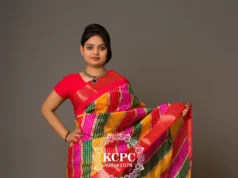The Half Saree Ceremony is a significant cultural event in India that marks a key transition in a young girl’s life. This tradition, deeply rooted in Indian culture, celebrates the coming of age of young girls as they step into adolescence. In this article, we will explore what the Half Saree Ceremony is, its traditional significance, and how it functions in today’s world.
1. What is the Half Saree Ceremony?
The Half Saree Ceremony, also known as “Ritu Kala” or “Langa Voni” in some regions, is a traditional ceremony celebrated primarily in South India. It signifies a girl’s transition from childhood to adolescence. The term “half saree” refers to the attire worn during this ceremony: a blouse, a long skirt, and a dupatta (a long scarf).
Historically, the Half Saree Ceremony has been a way to recognize and honor a girl’s growth and maturity. This ceremony holds a special place in various Indian communities, each with its unique customs and practices. In different regions, the significance of the ceremony can vary, but it generally symbolizes the girl’s readiness to assume more responsibilities and enter into her teenage years.
2. The Tradition of the Half Saree Ceremony
The traditional attire worn during the Half Saree Ceremony is both beautiful and symbolic. The half saree typically includes a colorful skirt, a matching blouse, and a dupatta. The attire is often adorned with intricate embroidery and embellishments, reflecting the cultural heritage and personal style.
The ceremony itself is accompanied by several rituals and customs. These can include religious prayers, special rituals performed by elders, and blessings from family members. The role of the family and community is pivotal in this ceremony, as it is a communal event celebrating the girl’s growth.
In South India, this ceremony is traditionally held when a girl reaches puberty. However, in other parts of India, variations of this ceremony might be observed with slight modifications in the attire and rituals.
3. The Function of the Half-Saree Ceremony
The primary function of the Half Saree Ceremony is to mark the transition of a young girl into adolescence. This rite of passage is important in many Indian cultures as it symbolizes the beginning of a new phase in life. It is a celebration of the girl’s growth and a recognition of her readiness to take on new roles and responsibilities.
Over time, the way this ceremony is celebrated has evolved. While traditional practices are still upheld, modern influences have introduced new elements to the ceremony. Today, many families blend traditional customs with contemporary styles, reflecting changes in social norms and fashion trends.
4. Preparation for the Half Saree Ceremony
Preparing for a Half Saree Ceremony involves several important steps. The planning and organization of the event are crucial to ensure everything runs smoothly. Choosing the right attire is one of the most significant aspects, with options varying in style, color, and design to match the girl’s preferences and cultural significance.
Invitations and guest list considerations are also essential. The ceremony is often a family affair, with close relatives and friends invited to share in the celebration. Some families might also enlist the help of a professional stylist or planner to ensure that every detail is perfect.
5. Modern Trends in Half-Saree Ceremonies
Modern trends have brought a fresh perspective to the Half Sarees Ceremony. Contemporary styles and fashion trends influence the attire and overall look of the ceremony. Innovations in traditional practices, such as incorporating modern designs and accessories, have become common.
Social media and modern influences have also played a role in shaping the ceremony. With more people sharing their experiences online, new ideas and trends quickly spread, leading to a blend of traditional and contemporary elements in the celebration.
6. FAQs
- Q1: What is the significance of the half saree in the ceremony?
- The half saree symbolizes the transition from childhood to adolescence, marking a girl’s growth and maturity.
- Q2: How is the Half Saree Ceremony celebrated differently in various regions of India?
- The ceremony varies across regions, with differences in attire, rituals, and customs reflecting local traditions.
- Q3: What are some traditional rituals performed during the Half Saree Ceremony?
- Common rituals include religious prayers, blessings from elders, and special ceremonies conducted by family members.
- Q4: How can I prepare for a Half Saree Ceremony?
- Preparation involves planning the event, choosing the attire, organizing invitations, and possibly working with a stylist or planner.
- Q5: Are there any modern trends influencing the Half Saree Ceremony?
- Yes, modern trends include contemporary fashion styles, innovations in traditional practices, and influences from social media.
- Q6: Why do girls wear half sarees?
- Girls wear half sarees during this ceremony to symbolize their transition into adolescence and to celebrate their growth.
- Q7: Can married women wear half sarees?
- Typically, half sarees are worn by young girls during the ceremony. Married women usually wear full sarees or other traditional attire.
- Q8: Who invented the half saree?
- The half saree is a traditional attire with ancient origins, and its exact inventor is not known, but it has been a part of South Indian culture for centuries.
- Q9: What is the difference between a half saree and a full saree?
- A half saree consists of a blouse, skirt, and dupatta, while a full saree is a single piece of fabric draped around the body.
- Q10: What is the full name of the half saree?
- The full name is not commonly used, but it is also known as “Langa Voni” or “Half-Sari.”
- Q11: Who wears half sarees?
- Half sarees are typically worn by young girls during their coming-of-age ceremonies, marking their transition from childhood to adolescence.
7. Conclusion
The Half Saree Ceremony is a cherished tradition that holds deep cultural significance. It marks a significant transition in a young girl’s life and is celebrated with a blend of traditional rituals and modern influences. Embracing this ceremony allows families to honor their cultural heritage while celebrating their loved ones’ growth. Share your experiences or plans for the Saree Ceremony in the comments below!
8. Additional Resources
Learn More: To read more about the cultural significance and history of this Ceremony, visit.
Related Articles: Explore other articles on traditional Indian ceremonies and cultural practices to gain a deeper understanding.













Wow, awesome weblog format! How long have you been running a
blog for? you made running a blog glance easy. The entire glance of your site is magnificent,
as well as the content!